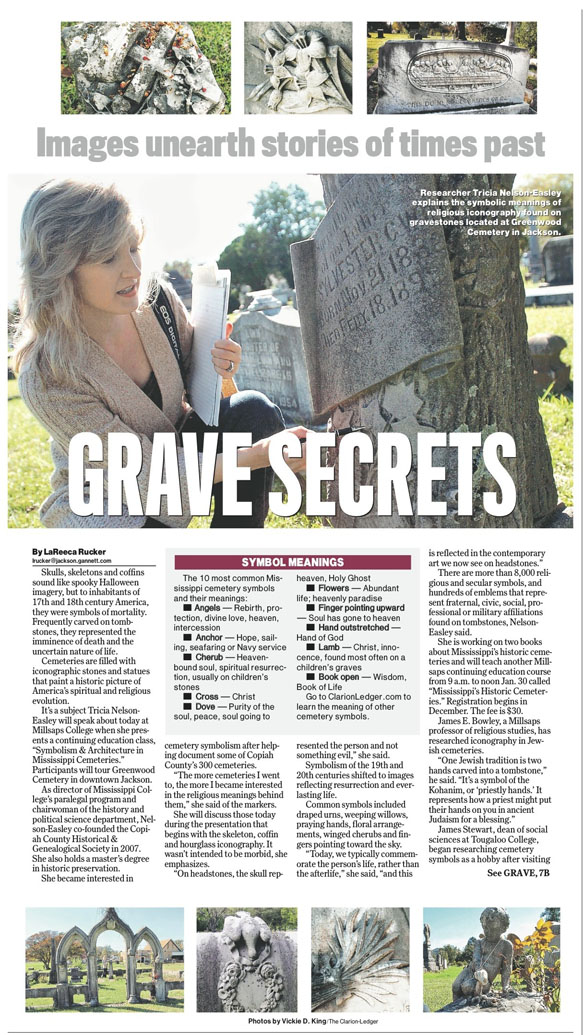Grave Secrets: Religious iconography reveals lives past
LaReeca Rucker:
The Clarion-Ledger
Skulls, skeletons and coffins sound like spooky Halloween imagery, but to inhabitants of 17th and 18th century America, they were symbols of mortality.
Frequently carved on tombstones, they represented the imminence of death and the uncertain nature of life. The Cemeteries are filled with iconographic stones and statues that paint a historic picture of America's spiritual and religious evolution.
It's a subject Tricia Nelson-Easley will speak about today at Millsaps College when she presents a continuing education class, "Symbolism & Architecture in Mississippi Cemeteries." Participants will tour Greenwood Cemetery in downtown Jackson.
As director of Mississippi College's paralegal program and chairman of the history and political science department, Nelson-Easley co-founded the Copiah County Historical & Genealogical Society in 2007. She also holds a master's degree in historic preservation.
She became interested in cemetery symbolism after helping document some of Copiah County's 300 cemeteries.
"The more cemeteries I went to, the more I became interested in the religious meanings behind them," she said of the markers.
She will discuss those today during the presentation that begins with the skeleton, coffin and hourglass iconography. It wasn't intended to be morbid, she emphasizes.
"On headstones, the skull represented the person and not something evil," she said.
Symbolism of the 19th and 20th centuries shifted to images reflecting resurrection and everlasting life.
Common symbols included draped urns, weeping willows, praying hands, floral arrangements, winged cherubs and fingers pointing toward the sky.
"Today, we typically commemorate the person's life, rather than the afterlife," she said, "and this is reflected in the contemporary art we now see on headstones."
There are more than 8,000 religious and secular symbols, and hundreds of emblems that represent fraternal, civic, social, professional or military affiliations found on tombstones, Nelson-Easley said.
She is working on two books about Mississippi's historic cemeteries and will teach another Millsaps continuing education course from 9 a.m. to noon Jan. 30 called "Mississippi's Historic Cemeteries." Registration begins in December. The fee is $30.
James E. Bowley, a Millsaps professor of religious studies, has researched iconography in Jewish cemeteries.
"One Jewish tradition is two hands carved into a tombstone," he said. "It's a symbol of the Kohanim, or 'priestly hands.' It represents how a priest might put their hands on you in ancient Judaism for a blessing."
James Stewart, dean of social sciences at Tougaloo College, began researching cemetery symbols as a hobby after visiting family burial grounds in Yazoo City.
"They had all of these interesting symbols and strange statues or emblems,"
he said. "I started looking into what these things really mean."
Stewart encountered a draped urn on many tombstones and learned that it indicates how the person died. "If a drape only covers one half of the urn, that means the person died prematurely, or it was a tragic death," he said.
Stewart believes the symbols are important.
"Many who may have been illiterate were able to look at the tombstone and immediately know what had happened and who was buried there," he said. "It's analogous to the old stained-glass windows that would teach you lessons in
church without saying anything."
Stewart said he has seen early Mississippi tombstones around the Natchez Trace with a skull and crossbones on them, sometimes bearing the Latin phrase "Momento mori," or "Remember you will die."
"That was a reminder to the mourners that they too will die and should turn from their wicked ways," he said. "Today, if you ordered a tombstone with a skull on it, they would think you were morbid, but 100 years ago, you were making a religious statement.
"They were trying to communicate something, and they can still communicate to us today if people take the time to see what they are saying."
Symbol Meanings
The 10 most common Mississippi cemetery symbols and their meanings:
Angels - Rebirth, protection, divine love, heaven, intercession
Anchor - Hope, sailing, seafaring or Navy service
Cherub - Heaven-bound soul, spiritual resurrection, usually on children's
stones
Cross - Christ
Dove - Purity of the soul, peace, soul going to heaven, Holy Ghost
Flowers - Abundant life; heavenly paradise
Finger pointing upward - Soul has gone to heaven
Hand outstretched - Hand of God
Lamb - Christ, innocence, found most often on a children's graves
Book open - Wisdom, Book of Life


